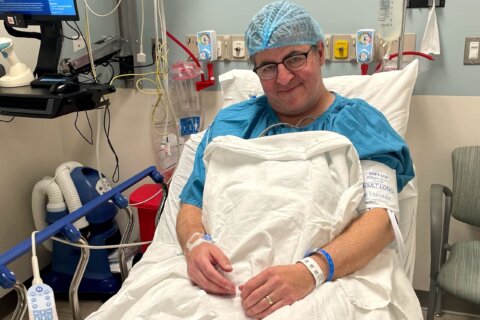It’s National Atrial Fibrillation Awareness Month and a Northern Virginia cardiologist wants to make sure people don’t ignore symptoms.
Atrial fibrillation is a quivering or irregular heartbeat that can lead to blood clots, stroke, heart failure and other heart-related complications.
“The biggest problem with atrial fibrillation is that it increases mortality. So patients that are diagnosed with atrial fibrillation, if they go untreated, their mortality increases significantly, and the most common cause of an increased mortality is because of stroke,” said Dr. Chirag Sandesara, a clinical cardiac electrophysiologist with Virginia Heart.
Symptoms of atrial fibrillation include fatigue, exhaustion, feeling very tired with exercise and palpitations — feeling like your heart is racing.
Tim Jennings, 56, of Ashburn, Virginia, said he knew something was wrong when he felt his heart flutter.
“That’s the only way I can describe it, in my chest, almost like, I just ate cold ice cream and it went down, but kind of fluttered in my chest area,” Jennings said.
After the second night in a row, Jennings decided it wasn’t normal.
“I wanted to have it checked out because I don’t want something to go wrong. I am at a point where I’ve got a great family, I’m looking to retire, and I don’t want to enjoy [retirement] having problems,” he said.
Risk factors for atrial fibrillation include obesity, sleep apnea, high blood pressure and coronary heart disease. Most people aren’t aware that they have atrial fibrillation when they are first diagnosed.
“This is a difficult diagnosis to make because atrial fibrillation can sometimes mimic other medical problems. Patients oftentimes come in with symptoms that are very vague, such as fatigue or some mild shortness of breath, difficulty with exercise, difficulty with sleeping at night. And these symptoms can be due to a variety of medical problems,” Sandesara said.
Stressing the importance of getting diagnosed, Sandesara explained how the fibrillation causes blood to pool in the atrium of the heart, “and if someone is unaware it’s happening and go on without necessary treatments, such as blood thinners, stroke sometimes becomes their first symptom of atrial fibrillation.”
The condition can be treated with medicine or a procedure called catheter ablation, which involves inserting a tube or a small wire through the patient’s leg into the heart.
“We find out where the atrial fibrillation signals are coming from. And we apply heat energy or cold energy to those areas to try and stop those signals from firing, and that should reduce the recurrence of atrial fibrillation in those particular patients,” Sandesara said.
Jennings had the outpatient procedure.
“At my age, I’d consider myself still young. And I wanted to address it immediately, and avoid long-term use of medication and a continued deterioration of my heart. So I chose the procedure,” he said.
Jennings’ message is listening to your doctors can help make the decision that is best for you.
To help prevent developing atrial fibrillation, Sandesara recommends staying fit.
“Being fit means staying active and exercising almost daily to try and maintain adequate cardiovascular fitness to increase your ability to stay active and also beat atrial fibrillation,” he said. “It turns out patients that are fit and healthy have less risk factors for atrial fibrillation occurrence than those that are unhealthy or unfit.”








